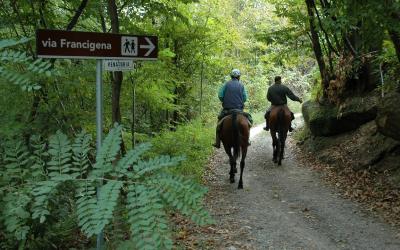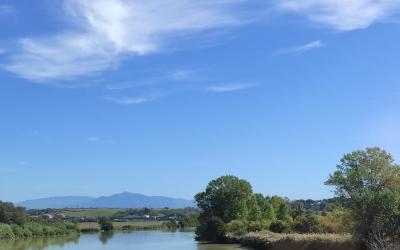Among the most famous and best-loved cities in the world, an inexhaustible treasure trove of art and history, Rome would not be Rome without the Tiber.
On foot or by bicycle, independently or with an organised group, the river offers many unexpected opportunities to experience the city in a new and active way, at any time of the year.
NOT TO BE MISSED
After crossing the Tevere-Farfa Nature Reserve, the Tiber continues its approach to Rome, leaving on the right the archaeological site of Lucus Feroniae and, a little further along the Via Flaminia, another exceptional site, the Villa “Ad gallinas albas” which once belonged to Livia, wife of Augustus.
Wedged between two great green lungs, in the territory of the municipality XV, the Regional Park of Veio on the right and the Marcigliana Nature Reserve on the left, the river reaches the GRA (the Rome ring road), at Castel Giubileo, where it has been powering the hydroelectric station since the 1950s.
This is the starting point of the Tiber Cycle Track which follows the course of the river for about 30 kilometres, making it possible to cross the city on two wheels and reach its southernmost part, the EUR quarter.
Having received its most important tributary, the Aniene, the Tiber enters the heart of the city and the Milvian Bridge appears. This is one of the oldest bridges in the capital, the site of historic battles, from Maxentius to Garibaldi, and today a lively meeting place on summer evenings.
From here, the Lungotevere begins, and continues for several kilometres, its sections taking on different names along the way; a large and busy road that extends above the river course. With its walls studded with large plane trees, it represents the 'Roman boulevard' par excellence.
From Duca di Aosta Bridge, the sports complex of the Foro Italico, built in the 1930s, where the Olympic Stadium is also located, can be seen on the right bank of the river.
Immediately after the Bridge of Music, inaugurated in 2011, is the gateway to the lively Flaminio quarter, in municipality II, which houses the MAXXI- National Museum of 21st-Century Arts and the Parco della Musica Auditorium.
Amidst splendid buildings and historic rowing clubs, we now come to the Pietro Nenni Bridge, over which passes a short overground section of the subway line A, before reaching the newest of the historic quarters, Prati, on the right bank of the river.
The historical stratification of Rome's Municipality I area, a UNESCO World Heritage Site since 1980, inhabited since prehistoric times, is reflected in the multiplicity of housing patterns with very different artistic and architectural styles. The uniqueness of its urban fabric is wonderfully represented in this part of the city by the coexistence of Historic Neighbourhoods and more modern Quarters.
A little further on, on the opposite bank, stands the Ara Pacis Museum, the new section of which, designed by Richard Meier, is well worth a visit, and the monumental Sant'Angelo Bridge, opposite the ancient Mausoleum of Hadrian, better known as Castel Sant'Angelo, now a National Museum.
Continuing along the Lungotevere, we now skirt the Borgo quarter and the 'dome' of St Peter's Basilica comes into view, marking the presence of the Vatican City.
And, immediately after, overlooked by the Janiculum Hill, is lively Trastevere, with its winding alleyways and splendid squares and its 15th-century humpback bridge, the elegant Sisto Bridge.
Among the most unusual places to visit in the quarter are the Botanical Garden at Palazzo Corsini, Villa Farnesina alla Lungara and the Doria Garden, commissioned by the famous Donna Olimpia and recently opened to the public.
Still following the course of the Tiber, along the cycle path that runs along the quay or along the Lungotevere, past the Garibaldi Bridge, the Tiber Island appears like a floating ship.
Here once stood many places of worship including the Temple of Aesculapius, god of Medicine, on the remains of which stands the Church of San Bartolomeo all'Isola, as well as modern hospitals still in use.
The island is connected to Trastevere by the Cestio Bridge, and to the Jewish quarter and the Velabro area by the Fabricio Bridge, one of the city’s oldest bridges; on the south side a portion of another imposing Roman bridge can be seen, called 'Ponte Rotto' (Broken Bridge).
Further on, on the left bank, towers one of the mythical seven hills, the Aventine. It is worth making a short diversion to easily reach the terrace of the Orange Garden and enjoy a magnificent view of the river.
On the side of the hill, connected by a ramp, are the so-called 'Grottoni', carved out of the structure of the ancient Rocca Savelli, and used as a repository for marble fragments in the 1930s; an extraordinary place which is shortly due to be opened to the public by the Rome Superintendency.
Returning to the Lungotevere, we continue towards the more modern part of the city, where manufacturing and commercial activities are located. In Testaccio, archaeological remains, including the traces of the grand Emporium and the Monte dei Cocci, merge with the residential architecture of the late-19th century, when the area was redesigned together with the creation of the Mattatoio (Abattoir), now a multi-purpose museum space as well as a university faculty building.
Immediately after, the river skims the Ostiense quarter, recognisable by the presence of the metal Gasometers, and then St Paul's with the imposing façade of the namesake Basilica, the mosaic of which, reconstructed in the late-19th century after a serious fire, is clearly visible from the Marconi Bridge.
Passing through the areas of Portuense and Magliana, populous residential neighbourhoods that preserve little known gems, such as the small church of Santa Passera, the river continues to flow through the EUR quarter, with its large boulevards and rationalist architecture, and then, beyond the Grande Raccordo Anulare (the Rome Ring Road), through the surrounding countryside dotted with historic suburbs, onto Ostia Lido.
Between the New Port of Ostia and the old Fiumicino lighthouse, the Tiber ends its course and, after a journey of 405 kilometres, flows into the waves of the Tyrrhenian Sea.
















